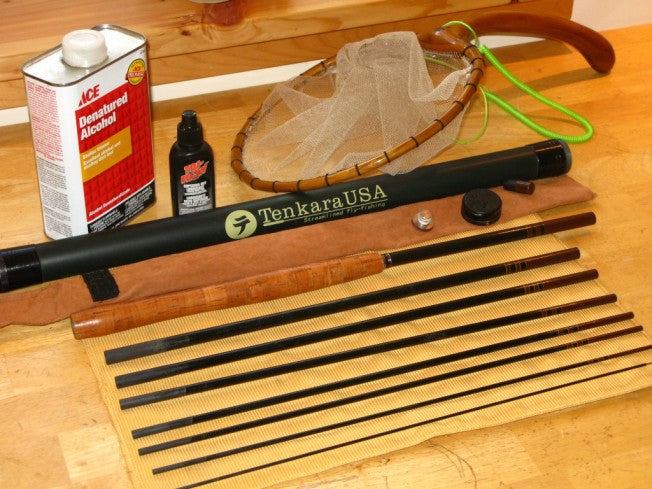Last year I had the pleasure of meeting Jay Pape at the first Tenkara Summit. Jay works for the National Forest Service out of Bozeman, Montana, and this year I had the opportunity to get to know and fish with him when I was visiting the area. I’m very thankful for his submission of the very helpful article that follows on gear maintenance.
Written by Jay Pape
Now that snow and ice has closed most of the local streams here in Bozeman, I use the long Montana nights to tie kebari and reflect on the many days enjoyed tenkara fishing this season.
Highlights of my last day on the water include sleet and snow plastered to my beard, a furled line frozen stiff by the wind AND a handful of beautiful rainbow trout. Back at the truck numb fingers struggled to collapse my 12’ Iwana and each section made nasty noises as they nested into each other. I didn’t
dare collapse the tip sections and quickly drove home to let everything thaw out. At this point the harsh realization set in- my season was over for a while and a bit of winter maintenance was in order.
Here are few tips to make sure your tenkara gear will be ready to go as soon as the streams open up:
- Remove the end cap and slide out each section of the rod. I then place them on towel to keep them from rolling onto the floor.

- With a turkey baster or syringe full of warm water I flush the inside of each section and blow any remaining water out before.
- When everything is dry I use a clean cloth saturated with denatured alcohol to wipe down each section. This removes the residue on the thicker end and evaporates quickly. Warm soapy water also works well.

-
Before reassembly I inspect the Lillian for damage and lubricate each section with Tri-Flow applied to another lint-free cotton rag or pad. TriFlow is a dry lubricant that repels dust/dirt and isn’t greasy like WD40.

- When my rod was new, I wanted to keep the cork grip from getting covered with black, sweaty grime. To prevent this, I applied a few coats of Zinsser Clear Shellac. If the shellac looks worn, I add a fresh coat.
- Once everything is dry, I apply a fresh wrap of white, PTFE (plumbers) tape to help keep the screw cap snug [note from Daniel: the newer tenkara rods have an o-ring on the caps, which prevents them from unscrewing, PTFE tape should not be necessary]. The rod tube also gets a thorough cleaning and the threads are dabbed with Tri-Flow to keep the end caps from binding.
- To clean the mesh of the tamo I fill the kitchen sink with hot soapy water, soak and rinse. This should be done after every outing to prevent the transport of invasive species. This is also a good time to inspect the net bag and make any needed repairs.

- Lastly, I wash my smelly waders and boots and let them air dry before storing them in my fishing bin.
I also go through all of my lines and replace the tippet rings or perfection loops. With everything put away in good condition I can tie kebari (and ski powder) knowing that I am ready to enjoy the streams as soon as the weather breaks.
